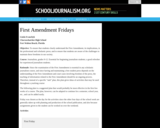
Have students bring articles on current events which either support or criticize the 1st Amendment
- Subject:
- Social Science
- Social Studies
- Material Type:
- Lesson
- Provider:
- School of Journalism
- Date Added:
- 09/07/2022
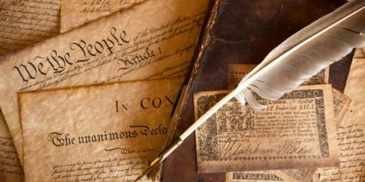
Amendment I: Freedom of religion, speech, and the press; rights of assembly and petition
Congress shall make no law respecting an establishment of religion, or prohibiting the free exercise thereof; or abridging the freedom of speech, or of the press, or the right of the people peaceably to assemble, and to petition the Government for a redress of grievances.

Have students bring articles on current events which either support or criticize the 1st Amendment
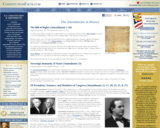
This webpage includes information about the amendments to the U.S. Constitution and their role in the history of the United States of America.

Students learn about the Fourth Amendment’s requirements for arrests and searches. Then in a paired writing activity, they take the role of television writers and create scenarios illustrating legal arrests and searches. Access to this resource requires a free educator login.

Do campaign donations qualify as speech? In Buckley v. Valeo (1976) the United States Supreme Court held that several key provisions of the Federal Election Campaign Act were unconstitutional. The decision became known for tying campaign donations and expenditures to Freedom of Speech under the First Amendment of the U.S. Constitution.
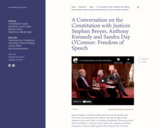
Justices Stephen G. Breyer, Anthony M. Kennedy and Sandra Day O'Connor and students discuss students' free speech rights in the Supreme Court cases Tinker v. Des Moines Independent Community School District and Morse v. Frederick. In the Tinker case, students wore black armbands to school in silent protest of the Vietnam War. The three students were sent home. In the Morse case, a student held up a sign that said âBong Hits 4 Jesusâ at a school-supervised parade and was subsequently suspended for 10 days
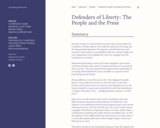
This lesson is based on the Annenberg Classroom video that explores the evolution of the free press doctrine, Freedom of the Press: New York Times v. United States

The original thirteen states that formed the United States included individuals from a variety of religious traditions. To ensure that the national government respected freedom of belief, freedom of conscience, and freedom of religious practice, the First Amendment prohibited the federal government from either establishing a national church or interfering with existing state religions. Since then the Supreme Court has created various "tests" to determine if government practices violate the Establishment Clause of the First Amendment. This lesson explores the history and principles behind this clause.

In this lesson, students are introduced to the notion of “freedom of the press” from the First Amendment and learn about the crucial role journalists and reporters play in keeping the citizens in a democratic society informed about their community, the nation, and the world. Access to this resource requires a free educator login.

In this lesson, students learn about how the U.S, Supreme Court has interpreted freedom of the press throughout in the 20th century and into the 21st century. Access to this resource requires a free educator login.

In this lesson, students learn about the Bill of Rights and analyze primary sources from the Library of Congress to identify freedoms and rights. They will explore the questions: What are our rights? What freedoms are most important to you? Access to this resource requires a free educator login.

This resource from the National Constitution Center includes an introduction, big questions, recorded class sessions, briefing documents, slide decks, and worksheets about the first amendment of the United States Constitutuion.

This resource from the National Constitution Center includes an introduction, big questions, recorded class sessions, briefing documents, slide decks, and worksheets about the first amendment of the United States Constitutuion.

In this lesson, students will gain an understanding of how the Supreme Court's interpretation of the First Amendment changed in light of the Fourteenth Amendment. They will also analyze Thomas Jefferson's Letter to the Danbury Baptist Association, evaluate the Supreme Court's application of Jefferson's metaphor about the wall of separation between church and state, and assess how much weight should be given to Jefferson's letter in determining the constitutionality of state action with respect to religion.

This resource from the National Constitution Center includes an introduction, big questions, recorded class sessions, briefing documents, slide decks, and worksheets about the first amendment of the United States Constitutuion.

This resource from the National Constitution Center includes an introduction, big questions, recorded class sessions, briefing documents, slide decks, and worksheets about the first amendment of the United States Constitutuion.

This resource from the National Constitution Center includes an introduction, big questions, recorded class sessions, briefing documents, slide decks, and worksheets about the first amendment of the United States Constitutuion.

This video covers the main parts of the first amendment in a fun way that is easy for kids to understand.

Charles Lindbergh was a genuine American hero. He was the first pilot to fly solo across the Atlantic. When his infant son was kidnapped, the trial of the alleged kidnapper developed into a sensational news story. The reaction of the public to this highly publicized crime, and the effects that modern publicity had on the jury, seriously challenged the limits of freedom of the press. The controversies raised by the media coverage of the Lindbergh kidnapping trial still resonate today. Access to this resource requires a free educator login.
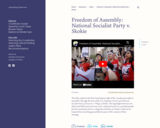
This film explores the First Amendment right of the âpeople peaceably to assembleâ through the lens of the U.S. Supreme Court case National Socialist Party of America v. Village of Skokie. The legal fight between neo-Nazis and Holocaust survivors over a planned march in a predominantly Jewish community led to a ruling that said the neo-Nazis could not be banned from marching peacefully because of the content of their message.
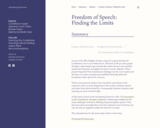
In this lesson, based on the Annenberg Classroom video âA Conversation on the Constitution: Freedom of Speech,â students gain insight into the many challenges involved in defining and protecting free speech. They also learn about principles that come from Supreme Court decisions and case law that are applied to define the limits for us today.